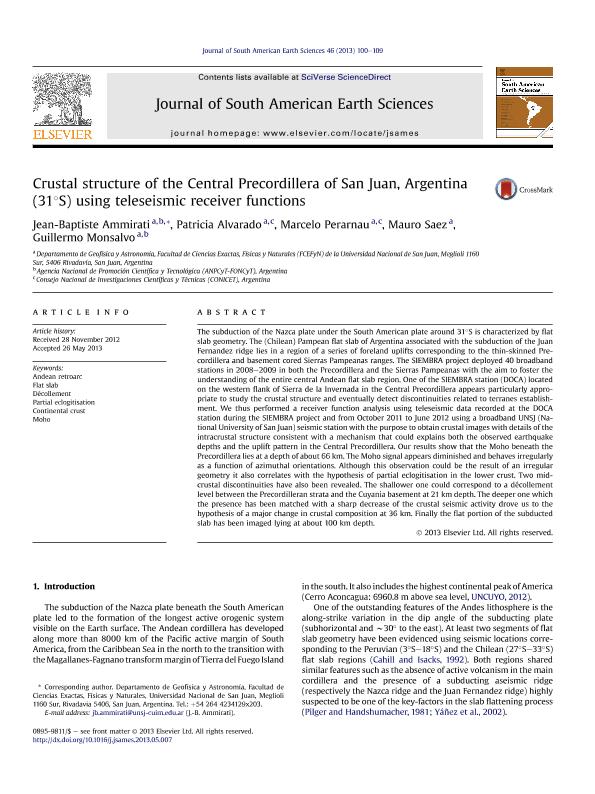Mostrar el registro sencillo del ítem
dc.contributor.author
Ammirati, Jean Baptiste

dc.contributor.author
Alvarado, Patricia Monica

dc.contributor.author
Perarnau, Marcelo Andres

dc.contributor.author
Saez, Mauro

dc.contributor.author
Monsalvo Ciancio, Victor Guillermo

dc.date.available
2017-09-28T19:49:02Z
dc.date.issued
2013-06
dc.identifier.citation
Ammirati, Jean Baptiste; Alvarado, Patricia Monica; Perarnau, Marcelo Andres; Saez, Mauro; Monsalvo Ciancio, Victor Guillermo; Crustal structure of the Central Precordillera of San Juan, Argentina (31°S) using teleseismic receiver functions; Elsevier; Journal of South American Earth Sciences; 46; 6-2013; 100-109
dc.identifier.issn
0895-9811
dc.identifier.uri
http://hdl.handle.net/11336/25355
dc.description.abstract
The subduction of the Nazca plate under the South American plate around 31°S is characterized by flat slab geometry. The (Chilean) Pampean flat slab of Argentina associated with the subduction of the Juan Fernandez ridge lies in a region of a series of foreland uplifts corresponding to the thin-skinned Precordillera and basement cored Sierras Pampeanas ranges. The SIEMBRA project deployed 40 broadband stations in 2008?2009 in both the Precordillera and the Sierras Pampeanas with the aim to foster the understanding of the entire central Andean flat slab region. One of the SIEMBRA station (DOCA) located on the western flank of Sierra de la Invernada in the Central Precordillera appears particularly appropriate to study the crustal structure and eventually detect discontinuities related to terranes establishment. We thus performed a receiver function analysis using teleseismic data recorded at the DOCA station during the SIEMBRA project and from October 2011 to June 2012 using a broadband UNSJ (National University of San Juan) seismic station with the purpose to obtain crustal images with details of the intracrustal structure consistent with a mechanism that could explains both the observed earthquake depths and the uplift pattern in the Central Precordillera. Our results show that the Moho beneath the Precordillera lies at a depth of about 66 km. The Moho signal appears diminished and behaves irregularly as a function of azimuthal orientations. Although this observation could be the result of an irregular geometry it also correlates with the hypothesis of partial eclogitisation in the lower crust. Two mid-crustal discontinuities have also been revealed. The shallower one could correspond to a décollement level between the Precordilleran strata and the Cuyania basement at 21 km depth. The deeper one which the presence has been matched with a sharp decrease of the crustal seismic activity drove us to the hypothesis of a major change in crustal composition at 36 km. Finally the flat portion of the subducted slab has been imaged lying at about 100 km depth.
dc.format
application/pdf
dc.language.iso
eng
dc.publisher
Elsevier

dc.rights
info:eu-repo/semantics/openAccess
dc.rights.uri
https://creativecommons.org/licenses/by-nc-sa/2.5/ar/
dc.subject
Andean Retroarc
dc.subject
Flat Slab
dc.subject
Décollement
dc.subject
Partial Eclogitisation
dc.subject
Continental Crust
dc.subject
Moho
dc.subject.classification
Oceanografía, Hidrología, Recursos Hídricos

dc.subject.classification
Ciencias de la Tierra y relacionadas con el Medio Ambiente

dc.subject.classification
CIENCIAS NATURALES Y EXACTAS

dc.title
Crustal structure of the Central Precordillera of San Juan, Argentina (31°S) using teleseismic receiver functions
dc.type
info:eu-repo/semantics/article
dc.type
info:ar-repo/semantics/artículo
dc.type
info:eu-repo/semantics/publishedVersion
dc.date.updated
2017-09-28T18:13:24Z
dc.journal.volume
46
dc.journal.pagination
100-109
dc.journal.pais
Países Bajos

dc.journal.ciudad
Ámsterdam
dc.description.fil
Fil: Ammirati, Jean Baptiste. Universidad Nacional de San Juan. Facultad de Ciencias Exactas, Físicas y Naturales. Departamento de Geofísica y Astronomía; Argentina. Ministerio de Ciencia. Tecnología e Innovación Productiva. Agencia Nacional de Promoción Cientifíca y Tecnológica; Argentina. Consejo Nacional de Investigaciones Científicas y Técnicas; Argentina
dc.description.fil
Fil: Alvarado, Patricia Monica. Universidad Nacional de San Juan. Facultad de Ciencias Exactas, Físicas y Naturales. Departamento de Geofísica y Astronomía; Argentina. Consejo Nacional de Investigaciones Científicas y Técnicas; Argentina
dc.description.fil
Fil: Perarnau, Marcelo Andres. Universidad Nacional de San Juan. Facultad de Ciencias Exactas, Físicas y Naturales. Departamento de Geofísica y Astronomía; Argentina. Consejo Nacional de Investigaciones Científicas y Técnicas; Argentina
dc.description.fil
Fil: Saez, Mauro. Universidad Nacional de San Juan. Facultad de Ciencias Exactas, Físicas y Naturales. Departamento de Geofísica y Astronomía; Argentina. Consejo Nacional de Investigaciones Científicas y Técnicas; Argentina
dc.description.fil
Fil: Monsalvo Ciancio, Victor Guillermo. Universidad Nacional de San Juan. Facultad de Ciencias Exactas, Físicas y Naturales. Departamento de Geofísica y Astronomía; Argentina. Consejo Nacional de Investigaciones Científicas y Técnicas; Argentina. Ministerio de Ciencia. Tecnología e Innovación Productiva. Agencia Nacional de Promoción Cientifíca y Tecnológica; Argentina
dc.journal.title
Journal of South American Earth Sciences

dc.relation.alternativeid
info:eu-repo/semantics/altIdentifier/url/http://www.sciencedirect.com/science/article/pii/S0895981113000837
dc.relation.alternativeid
info:eu-repo/semantics/altIdentifier/doi/http://dx.doi.org/10.1016/j.jsames.2013.05.007
Archivos asociados
